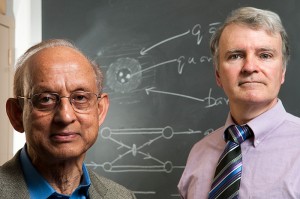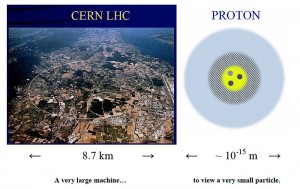
Two theoretical physicists at the University of Connecticut and their colleagues are eager for the results of an experiment scheduled next fall at the new Large Hadron Collider (LHC) in Switzerland.
If the experiment confirms their work, it could change the way scientists think about protons, the positively charged particles that, along with neutrons, make up the nucleus of an atom.
Munir Islam, professor emeritus and research professor of physics, and Richard Luddy, research scientist in the physics department who received his Ph.D. here in 2006, and two European colleagues have reported a model of the structure of the proton.
The structure of the proton is not yet known. If their model is confirmed by the LHC experiment, it will be a major step forward in our understanding of the proton, the physicists say.
How small is the proton they are studying? So small that it will be “seen” not visually, but virtually, the scientists explain. Its size is described by 14 zeros followed by one to the right of a decimal point, “a millionth of a billionth” of a meter.

The LHC went online in November 2009 after an interrupted start-up in 2008. Just this week, it “smashed” its first protons, or achieved its first proton-proton collisions.
The experiments in Switzerland bring together protons, among the tiniest of particles, and the LHC, the world’s largest scientific instrument and highest energy particle collider. The LHC is located at CERN, the European Center for Nuclear Research, near Geneva.
The proton model that Islam has worked on for more than 30 years shows a proton with three layers. Confined in its core are three quarks, or point-like subatomic particles, surrounded by two rings of “clouds.” The ring closest to the core has what the physicists describe as an exotic charge, a “baryonic charge.” The outer cloud ring is composed of quarks and anti-quarks in a condensed state.
While the theorists have tested this model using experiments done over 25 years at smaller particle colliders at CERN and at Fermilab (the National Accelerator Laboratory near Chicago), the upcoming experiment will get the high detail that is needed to see if their theory is correct.
“With these large colliders – the whole concept is, it’s just like adding more and more pixels to a camera,” says Luddy, to achieve finer, more precise detail.
The LHC accelerator at CERN is four times larger than Fermilab’s and has seven times its energy. The LHC’s tunnel, in which opposing particle beams collide at nearly the speed of light, is 17 miles long, a giant circle 100 meters underneath parts of Switzerland and France. It has been called the fastest racetrack on earth.
The LHC is not yet running at full speed; so far, it is planned for use at about half of its maximum energy.
Islam does not expect preliminary results on next fall’s experiment until 2011. After that, the LHC will increase its level of energy to 14 TeV, the equivalent of a 14 billion-volt kick to an electron.
Experimental time at particle accelerators is allotted to groups that may include hundreds of scientists studying similar fundamental particle physics problems. The experiment that Islam is waiting for will be run by the TOTEM collaboration of scientists, who study elastic scattering, in which two protons collide head-on and scatter without producing other particles. It is part of an experimental program that will calibrate the new LHC.
Islam and Luddy’s colleagues in developing the proton model are Jan Kaspar of the Academy of Sciences of the Czech Republic and Alexei Prokudin, formerly of the University of Turin and now at the Thomas Jefferson National Accelerator Facility in Virginia.
The group published a paper about their work in the December 2009 issue of CERN Courier, the International Journal of High-Energy Physics.
Luddy has worked on the problem of modeling the proton for nine years. Islam, who came to UConn in 1967 after earning his Ph.D. at Imperial College, London and doing research there and at Brown University, has been studying it much longer. The first UConn Ph.D. student who worked on the theory for his doctoral dissertation, Jerry Heines, finished his degree in 1979.
“To come to this point has taken us 30 years,” says Islam.
And it has taken a machine as powerful as the LHC at CERN to see if the predicted model is valid.
Other groups of physicists have differing theories about the structure of the proton, Islam says.
If next fall’s experiment confirms the model of the proton proposed by Islam and his colleagues, it will be a major step forward in scientists’ understanding of the proton, the four collaborators say.
“The consequent discovery of the structure of the proton at the LHC at the beginning of the 21st century would be analogous to the discovery of the structure of the atom…at the beginning of the 20th century,” they wrote in the CERN Courier.


